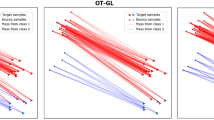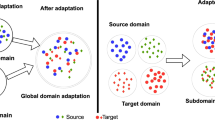Abstract
The paper has proposed a linear unsupervised transfer learning (LUTL). Therefore, a cost function has been introduced. In the cost function of the proposed LUTL, the aim is to minimize the difference between the distribution of the transformed source domain (SD) data and the distribution of the target domain (TD) data. In the proposed cost function, it is also targeted to preserve the local structures of the untransformed SD data. Three mechanisms have been proposed for the preservation of local structures in the untransformed SD data: (1) minimization of the distances between the data pairs that are similar to each other in the untransformed SD data, (2) preservation of the clusters emerged in the untransformed SD data and finally (3) their combination. The optimization problem has emerged as a nonlinear one. Two techniques have been introduced to obtain an approximation of the optimal weight matrix. Each technique guarantees to reach a local optimum, but no one guarantees to reach the global solution. While the first method is an iterative one, the second is a relaxed version of the optimization problem. The paper shows also experimentally that the proposed techniques overshadow the state-of-the-art methods.





Similar content being viewed by others
References
Absil PA, Mahony R, Sepulchre R (2008) Optimization algorithms on matrix manifolds. Princeton University Press, Princeton
Bache K, Lichman M (2013) UCI machine learning repository. http://archive.ics.uci.edu/ml. Accessed Aug 2013
Bay H, Ess A, Tuytelaars T, Gool LV (2008) Speeded-up robust features (SURF). Comput Vis Image Underst 110:346–359
Boyd S, Vandenberghe L (2006) Convex optimization. Cambridge University Press, New York
Caruana R (1997) Multitask learning. Mach Learn 28(1):41–75
Chen Q, Xue B, Zhang M (2015) Generalisation and domain adaptation in GP with gradient descent for symbolic regression. In: CEC 2015, pp 1137–1144
Chopra S, Balakrishnan S, Gopalan R (2013) Dlid: deep learning for domain adaptation by interpolating between domains. In: ICML workshop on challenges in representation learning
Dai W, Yang Q, Xue GR, Yu Y (2007) Boosting for transfer learning. In: International conference on machine learning, pp 193–200
Duan L, Xu D, Tsang IWH (2012) Domain adaptation from multiple sources: a domain-dependent regularization approach. IEEE Trans Neural Netw Learn Syst 23:504–518
Feng L, Ong Y, Lim M, Tsang I (2014) Memetic search with inter-domain learning: a realization between CVRP and CARP. IEEE Trans Evolut Comput. https://doi.org/10.1109/TEVC.2014.2362558
Fernando B, Habrard A, Sebban M, Tuytelaars T (2013) Unsupervised visual domain adaptation using subspace alignment. In: International conference in computer vision, pp 2960–2967
Ghifary M, Kleijn WB, Zhang M (2014) Domain adaptive neural networks for object recognition. In: 13th Pacific Rim international conference on artificial intelligence, pp 898–904
Gong B, Shi Y, Sha F, Grauman K (2012) Geodesic flow kernel for unsupervised domain adaptation. In: IEEE conference on computer vision and pattern recognition, pp 2066–2073
Gopalan R, Li R, Chellappa R (2011) Domain adaptation for object recognition: an unsupervised approach. In: International conference in computer vision, pp 999–1006
Guo K, Wu S, Xu Y (2017) Face recognition using both visible light image and near-infrared image and a deep network. CAAI Trans Intell Technol 2(1):39–47
Hoffmann H (2007) Kernel PCA for novelty detection. Pattern Recognit 40:863–874
Jiang W, Zavesky E, Chang SF, Loui A (2008) Cross-domain learning methods for high-level visual concept classification. In: International conference on image processing, pp 161–164
Jhou I, Liu D, Lee DT, Chang S (2012) Robust visual domain adaptation with low-rank reconstruction. In: CVPR, pp 2168–2175
Li Z, Liu J, Tang J, Lu H (2015) Robust structured subspace learning for data representation. IEEE Trans Pattern Anal Mach Intell 37(10):2085–2098
Li Z, Liu J, Yang Y, Zhou X, Lu H (2014) Clustering-guided sparse structural learning for unsupervised feature selection. IEEE Trans Knowl Data Eng 26(9):2138–2150
Liu H, Hu L, Ma L (2017) Online RGB-D person re-identification based on metric model update. CAAI Trans Intell Technol 2(1):48–55
Löfberg J (2004) YALMIP: a toolbox for modeling and optimization in MATLAB. In: Proceedings of the CACSD conference, Taiwan Taipei
Long M, Wang J (2015) Learning transferable features with deep adaptation networks. CoRR, arXiv:1502.02791
Long M, Wang J, Ding G, Sun J, Yu P (2013) Transfer feature learning with joint distribution adaptation. In: IEEE International conference on computer vision (ICCV), pp 2200–2207
Mencia EL (2010) Multilabel classification in parallel tasks. In: Working notes of the second international workshop on learning from multi-label data, Haifa, Israel, 2010, pp 20–36
Oquab M, Bottou L, Laptev I, Sivic J (2014) Learning and transferring mid-level image representations using convolutional neural networks. In: IEEE conference on computer vision and pattern recognition, conference version of the paper. https://hal.inria.fr/hal-00911179. Accessed Aug 2013
Pan SJ, Tsang I, Kwok J, Yang Q (2011) Domain adaptation via transfer component analysis. IEEE Trans Neural Netw 22(2):199–210
Pan SJ, Yang Q (2010) A survey on transfer learning. IEEE Trans Knowl Data Eng 22(10):1345–1359
Pezeshki A, Scharf LL, Chong EK (2010) The geometry of linearly and quadratically constrained optimization problems for signal processing and communications. J Frankl Inst 347:818–835
Saenko K, Kulis B, Fritz M, Darrell T (2010) Adapting visual category models to new domains. In: Computer vision ECCV 2010, series lecture notes in computer science, vol 6314. Springer, Berlin, pp 213–226
Song XP, Huang C, Townshend JR (2017) Improving global land cover characterization through data fusion. Geo-spatial Inf Sci 20(2):141–150
Shi X, Fan W, Ren J (2008) Actively transfer domain knowledge. In: European conference on machine learning, pp 342–357
Sugiyama M, Nakajima S, Kashima H, von Bünau P, Kawanabe M (2007) Direct importance estimation with model selection and its application to covariate shift adaptation. In: Proceedings of neural information processing systems, pp 1962–1965
Sun B, Feng J, Saenko K (2017) Correlation alignment for unsupervised domain adaptation. In: Csurka G (ed) Domain adaptation in computer vision applications. Advances in computer vision and pattern recognition. Springer, Cham
Tagare HD (2011) Notes on optimization on Stiefel manifolds, Tech. Rep., Department of Diagnostic Radiology, Department of Biomedical Engineering, Yale University
Tan F, Li L, Zhang Z, Guo Y (2016) A multi-attribute probabilistic matrix factorization model for personalized recommendation. Pattern Anal Appl 19(3):857–866
Tsoumakas G, Katakis I, Vlahavas I (2008) Effective and efficient multilabel classification in domains with large number of labels. In Working Notes of the ECML PKDD’08 workshop on mining multidimensional data, Antwerp, Belgium, 2008
Tzeng E, Hoffman J, Zhang N, Saenko K, Darrell T (2014) Deep domain confusion: maximizing for domain invariance. CoRR, arXiv:1412.3474
Wan C, Pan R, Li J (2011) Bi-weighting domain adaptation for cross-language text classification. In: 22th International joint conference on artificial intelligence, pp 1535–1540
Wei B, Pal C (2010) Cross lingual adaptation: an experiment on sentiment classifications. In: Proceedings of the ACL 2010 conference short papers. Association for Computational Linguistics, pp 258–262
Wen Z, Yin W (2013) A feasible method for optimization with orthogonality constraints. Math Program 142:397–434
Xia R, Zong C, Hu X, Cambria E (2013) Feature ensemble plus sample selection: domain adaptation for sentiment classification. IEEE Intell Syst 28(3):10–18
Xue Y, Liao X, Carin L, Krishnapuram B (2007) Multi-task learning for classification with Dirichlet process priors. J Mach Learn Res 8:35–63
Yang J, Yan R, Hauptmann AG (2007) Cross-domain video concept detection using adaptive SVMs. In: International conference on multimedia, pp 188–197
Yang M, Zhang L, Feng X, Zhang D (2011) Fisher discrimination dictionary learning for sparse representation. In: ICCV, pp 543–550
Yang X, Xie L, Han J, Wang Z (2017) Cognitive-affective regulation process for micro-expressions based on Gaussian cloud distribution. CAAI Trans Intell Technol 2(1):56–61
Zhang Y, Yeung D-Y (2010) A convex formulation for learning task relationships in multi-task learning. In: Proceedings of the 26th conference on uncertainty in artificial intelligence, pp 733–742
Zhang Y, Yeung D-Y (2014) A regularization approach to learning task relationships in multitask learning. ACM Trans Knowl Discov Data 8(3):12
Zhao B, Gao L, Liao W, Zhang B (2017) A new kernel method for hyperspectral image feature extraction. Geo-spatial Inf Sci 20(4):309–318
Acknowledgements
The paper has been extracted from Amin Pirbonyeh’s PhD thesis. He is undersupervision of Hamid Parvin and Vahideh Rezaie. Amin Pirbonyeh’s consultants have been Samad Nejatian and Mehdi Mehrabi.
Author information
Authors and Affiliations
Corresponding author
Rights and permissions
About this article
Cite this article
Pirbonyeh, A., Rezaie, V., Parvin, H. et al. A linear unsupervised transfer learning by preservation of cluster-and-neighborhood data organization. Pattern Anal Applic 22, 1149–1160 (2019). https://doi.org/10.1007/s10044-018-0753-9
Received:
Accepted:
Published:
Issue Date:
DOI: https://doi.org/10.1007/s10044-018-0753-9




